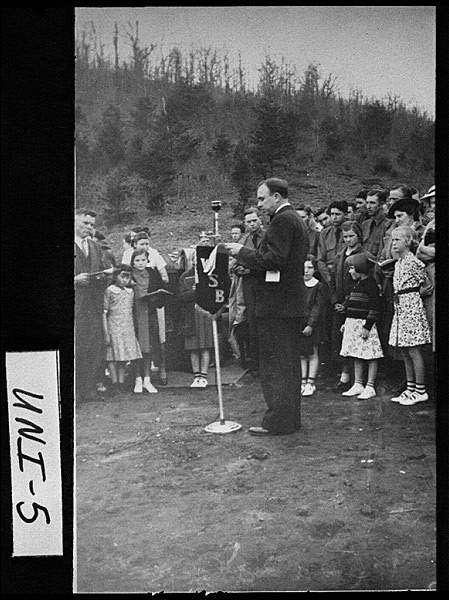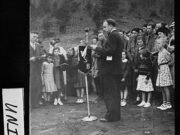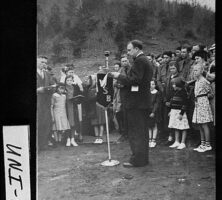Electric cooperatives (co-ops), also known as electric membership corporations (EMCs) or rural electric membership corporations (REMCs), have served Georgia’s rural regions and counties since the mid-1930s. In 2016 forty-one individual co-ops, all members of the umbrella organization Georgia EMC, provided electricity to 157 of the state’s 159 counties, or approximately 73 percent of Georgia’s land area.
Rural Electrification Administration
In 1935, during the Great Depression, only about 10 percent of rural Americans had access to electricity, in contrast to 90 percent of urban Americans. The main cause of this disparity was the cost of constructing power lines. It was simply not profitable for companies to string miles and miles of cable to service widely dispersed farms. This difference between the farm and the city created a significant cultural division. The electric lightbulb, invented in 1879, transformed the urban landscape, while the 1920s ushered in a variety of electric appliances, including phonographs, vacuum cleaners, refrigerators, and radios. These new appliances were all but useless to homes without electricity.

Courtesy of Georgia Archives.
On May 11, 1935, U.S. president Franklin D. Roosevelt signed an executive order to establish the Rural Electrification Administration (REA), which distributed low-cost loans, grants, and structural templates to groups of rural residents, as part of the president’s New Deal program. (The U.S. Congress endorsed this order the following year by passing the Rural Electrification Act.) Many of these rural groups organized as co-ops (tax-exempt, nonprofit entities owned by the members they serve), using the REA money to erect and maintain their own power lines.
The REA’s loans were effective. By 1939 the REA had supported the creation of 417 co-ops across the country. About 25 percent of rural America was electrified by that time—a 15 percent increase over four years. Georgia especially benefitted from REA-subsidized loans. Seventy percent of Georgia’s population lived in rural areas during the 1930s, and by 1939 the state’s farmers and rural residents had founded thirty-three co-ops. These co-ops have all remained active to the present day, along with eight more created since 1939.
Founding of Individual Cooperatives
Scattered across the state, Georgia’s forty-one co-ops are: Altamaha EMC, Amicalola EMC, Blue Ridge Mountain EMC, Canoochee EMC, Carroll EMC, Central Georgia EMC, Coastal Electric Cooperative, Cobb EMC, Colquitt EMC, Coweta-Fayette EMC, Diverse Power, Excelsior EMC, Flint Energies, Grady EMC, GreyStone Power Corporation, Habersham EMC, Hart EMC, Irwin EMC, Jackson EMC, Jefferson Energy Cooperative, Little Ocmulgee EMC, Middle Georgia EMC, Mitchell EMC, North Georgia EMC, Ocmulgee EMC, Oconee EMC, Okefenokee REMC, Planters EMC, Rayle EMC, Satilla REMC, Sawnee EMC, Slash Pine EMC, Snapping Shoals EMC, Southern Rivers Energy, Sumter EMC, Three Notch EMC, Tri-County EMC, Tri-State EMC, Upson EMC, Walton EMC, and Washington EMC.
All the state’s co-ops met similar regulatory requirements in their quest to secure funding from the REA. After farmers in a particular region had agreed to form a co-op, they elected a board of trustees or directors. This group was generally in charge of hiring a general manager, sometimes called a “president/CEO,” who took charge of the practical day-to-day footwork required by the REA to receive federal assistance. The general manager hired linemen and a project survey manager, for example, while the board retained an attorney and helped to secure easement rights (i.e., permission from landowners to use parts of their land) for electric lines. Members of the co-op paid for all this work. The cost of joining a co-op was usually about $5 a month, though many rural residents could only pay through labor.
A successful co-op proposal included maps, detailed budgets, and proof that the proposed co-op would only serve customers who lacked access to traditional, private power companies. Once a potential co-op secured all this information, its founders usually endured an agonizing waiting period as the understaffed REA examined the proposal, secured federal funding for successful proposals, and arranged a power wholesaler for the new co-op.
Economic and Cultural Effects
The arrival of a co-op within a region produced significant lifestyle and economic changes for its members. Lightbulbs, for example, made dark streets safer and night schools more feasible. Electric irons were a great improvement on their charcoal-filled counterparts because they were cleaner and didn’t require a lit stove, thereby reducing the heat in homes on hot summer days. Radios brought the age of mass communication into farm families’ living rooms, while labor-saving electrical appliances like the dishwasher, the washing machine, and the refrigerator-sized “magnetron” (or “microwave”) all beckoned rural communities to become electrified as soon as possible.
These marvels also had economic consequences. One U.S. Department of Agriculture study, for example, found that in 1919 farmers would save ten hours of pumping water each week—with the founding of co-ops, such work could be done with an electric pump. Rural electricity particularly benefited the poultry and dairy industries. Water could be pumped to chickens, instead of hauled by hand, and electric lights and milking machines allowed dairy farmers to milk more cows more often.
Thanks in part to electric co-ops, farms in Georgia and across the country became much more efficient. In 1930, 23 percent of the nation’s total workforce worked in agriculture. By 1945 that number had dropped to 17 percent, but the average farm size increased from about 160 acres in 1930 to about 190 acres in 1945. Crop yields increased as well during that time frame.
Selected Cooperative Profiles
All of Georgia’s co-ops, by virtue of their rural service and association with the REA, share similar histories. The co-ops profiled below represent different areas of the state, and each tackles challenges specific to its geographic region.
North Georgia EMC
North Georgia EMC is the second-oldest co-op in Georgia and the only electric co-op that serves Georgia’s Valley and Ridge and Appalachian Plateau regions. It was chartered by the state on May 11, 1936, exactly a year after Roosevelt signed the REA into existence. Unlike a large majority of Georgia’s electric co-ops, North Georgia EMC buys electricity from the Tennessee Valley Authority instead of from Oglethorpe Power Corporation.
North Georgia EMC’s power lines were first energized by the TVA on July 14, 1936, in Catoosa County, and the co-op’s first directors were R. H. Bandy, R. P. Brison, T. W. Colvard Jr., Joe B. Davis, R. L. Fuller Sr., E. P. Hall, and J. C. Johnston. Today, North Georgia EMC operates thirty-four substations and 6,400 miles of line in seven counties: Catoosa, Chattooga, Floyd, Gordon, Murray, Walker, and Whitfield.
Habersham EMC
Residents of the extreme northeast part of the state founded Habersham EMC on July 25, 1938. The co-op serves the rural parts of Habersham, Hall, Rabun, Stephens, and White counties.
Habersham EMC was first located in a small storefront in Clarkesville, with three employees. In 1938 the co-op hired the Atlanta-based engineering firm J. B. McCrary to build power lines. Seventy miles of line were energized on May 15, 1939, in Habersham, Rabun, and White counties.
In 1942 the board of directors, made up of representatives elected by co-op members, increased the number of directors from seven to nine. By 1945 the cooperative had built 392 miles of electrical line and served 1,663 consumers. In November 1958 it moved from its original headquarters to a location along Highway 115 in Clarkesville. To cater to the co-op’s growing needs, an engineering and operations facility opened in January 2005, and a new administrative building opened in July 2006.
In 2013 the co-op produced an audio travel guide and booklet entitled Experience North Georgia to commemorate its seventy-fifth anniversary. The guide, narrated by local folk artist John Kollock, featured seventy-five “must see” northeast Georgia attractions. Habersham EMC’s work on the guide won it Georgia EMC’s “EMC of the Year” and “Community Service and Volunteerism” award for 2013.
In 2015 Habersham EMC served 33,000 different residential and commercial meters and maintained 3,726 miles of electrical lines.
Jackson EMC
J. W. Jackson, a county extension agent in Jackson County, started advocating the creation of an electric co-op in newspaper columns shortly after Roosevelt created the REA in 1935. In school district and civic club meetings across the northeast Piedmont, residents debated the merits of forming their own electric co-op.
The first proposal produced by these meetings was rejected by the REA. After two more years of volunteer work, the REA accepted a second proposal. In 1938 the co-op was chartered as Jackson EMC. Based in Jackson County, it served the rural parts of Banks, Barrow, Clarke, Hall, Franklin, Gwinnett, Jackson, and Madison counties. Representatives from the co-op broke ground on the first leg of an electric distribution system in January 1939, and lines were first electrified the following April. By 1940 Jackson EMC served nearly 2,000 electric meters and maintained 680 miles of wire. Radios and electric irons were the most popular items among the members’ rural residents.
Jackson EMC grew along with the region, spurred by the construction of Interstate 85 and a robust poultry industry. In 1980, as the inflation and recession of the 1970s gave way to massive local economic growth, Jackson EMC expanded at record rates. The co-op increased its industrial and commercial accounts by 63 percent over five years in the early 1980s. Gwinnett County was the fastest-growing county in the nation at that time, and farmland in the service area was replaced with shopping malls and industries like Kubota, Nikon, and Rockwell International.
Between 1980 and 2000, the co-op tripled in size, adding more than 114,773 service meters and 8,200 miles of electrified wire. Forty-four substations were built between 1969 and 1999. It also expanded into other customer service roles, forming in 1998 a joint subsidiary with neighboring Walton EMC called EMC Security, which provides home and commercial security services.
In the 2000s population growth in the service area shifted from Gwinnett County to Barrow, Hall, and Jackson counties. The co-op continued to grow, though at a slower rate, serving 21 percent more meters in the first years of the new millennium. The co-op has increased its focus on customer service, opening new billing and call centers. It has also adapted to the challenges of providing power to large, complex new buildings, such as the Infinite Energy Center in Duluth and the Haverty’s Eastern Distribution Center in Braselton—a far cry from the irons and radios of the late 1930s.
The co-op marked its seventy-fifth anniversary in 2013, producing an interactive multimedia timeline about the co-op’s history and sponsoring reenactments of life in rural Georgia before the arrival of electricity. As of 2015 Jackson EMC served more than 219,000 meters, making it the largest electric co-op in Georgia and, in terms of meters served, one of the largest in the United States.
Colquitt EMC
Members of the Moultrie Chamber of Commerce and local electrification enthusiast Reed Bingham began discussing electrification as an important step for rural development as early as 1934. When Roosevelt created the REA in 1935, officials from Colquitt County quickly hired Bingham to survey the feasibility of an electric co-op.
These plans were actualized on September 28, 1936, when the Colquitt County Rural Electric Company (later Colquitt EMC) was chartered. To meet REA requirements, the new co-op signed a contract to build 270 miles of electric line serving 1,040 customers. The co-op’s members also elected Cliff Jenkins as president, W. M. Tillman as vice president, and W. W. King as secretary-treasurer. John Suber and Van T. Crosby were named directors. A fifteen-mile stretch of electric line was energized by July 1936, and some customers reportedly “burned every light in the house well past midnight.” By 1945 the Colquitt co-op served nearly 4,000 customers and operated 1,183 miles of line, displaying steady growth despite the disruption of World War II (1941-1945).
Colquitt EMC moved from its downtown location to a more rural Moultrie location in 1950. It later opened district and branch offices in Adel, Nashville, Quitman, Tifton, and Valdosta. In 2015 Colquitt EMC operated more than 62,000 electric meters.
Georgia EMC
Walter Harrison, known in Georgia as “Mr. Rural Electrification,” was a state legislator as well as a founder and forty-eight-year director of Planters EMC (based in Millen). He also served as the manager of Georgia EMC for twenty-three years, the editor of Rural Georgia (later Georgia Magazine), and the president of the National Rural Electric Cooperative Association (NRECA).
Since its founding, Georgia EMC has been a statewide trade association that works to further the political and economic interests of Georgia’s electric co-ops. All forty-one of the state’s co-ops are represented by Georgia EMC, which also represents Oglethorpe Power Corporation (OPC), Georgia Transmission Corporation (GTC), and Georgia System Operations Corporation (GSOC). Georgia EMC lobbies lawmakers to ensure that new laws benefit its members, partners with the Georgia Department of Economic Development to assist co-ops in improving the economic vitality of the communities they serve, provides member co-ops with media relations and communications support, and offers youth and professional training, as well as education and safety programs. Georgia EMC’s board of directors is made up of representatives from its forty-one member co-ops, who elect one president/CEO.
In addition to providing legislative representation and economic and community development resources, Georgia EMC supports a variety of statewide youth education programs, including the Washington Youth Tour, where student delegates from Georgia join more than 1,400 young people from across the country to meet local and national political leaders; the EMC/Future Farmers of America (FFA) Electrification Contest, a contest in which students demonstrate their electrical wiring and communication skills for a scholarship; and the Walter Harrison Scholarship, which distributed more than $171,000 in college scholarships to students on the basis of academic achievement and financial need between 1985 and 2015. These education programs have produced many notable alumni, including Terry England, a state representative from Auburn (Barrow County).
Georgia EMC also sponsors statewide professional education programs. The Line Worker Apprenticeship Training Program, for example, trains co-op employees to become certified as senior “journeymen linemen” in conjunction with the Tennessee Valley Public Power Association. Georgia EMC also organizes classes for Georgia co-ops that want to become accredited in the NRECA and statewide safety accreditation programs.
Finally, Georgia Magazine, Georgia EMC’s monthly magazine, was founded in 1945 as the newspaper tabloid Rural Georgia to educate the general public about electricity basics. With a readership of approximately 1.2 million per month in 2016, it is the largest monthly magazine in the state. The publication celebrated its seventieth anniversary in 2015, and its news stories, recipes, and profiles of important Georgians have continued to prove popular with members.





